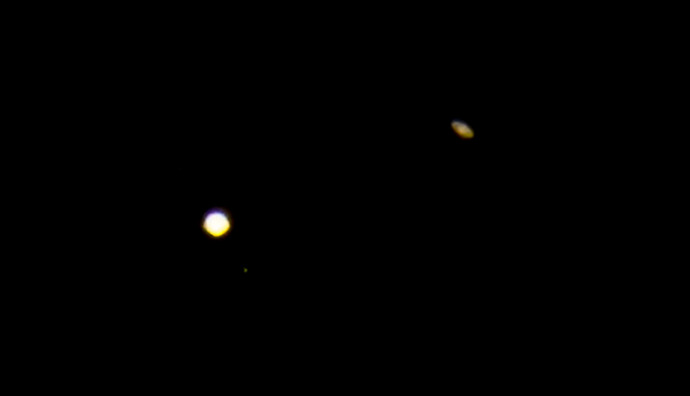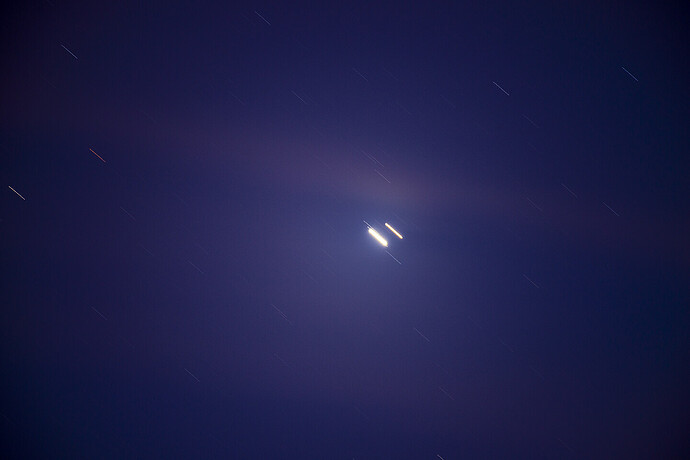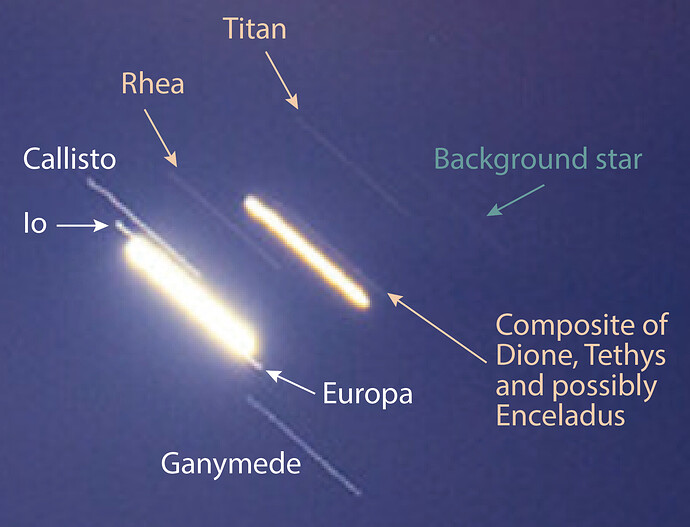Sorry to hear that too @Just-B  I hope it’s not too involved and $$$
I hope it’s not too involved and $$$ 
My camera gear isn’t particularly well-suited for astro photography nor is it my forte. These shots are simply me playing around from my driveway.
Viewed in Photoshop at 100%, this first shot just looks like a couple of white pixels in a field of black. This crop is zoomed way in. You can actually make out Saturn’s details a little bit.
While trying to get the right exposure, I realized how fast the planets were moving. So this second shot is a 30 second exposure to capture their movement.
That’s pretty awesome Steve!
Very cool.
I have the telescope setup and ready to go - but have had nothing but cloud cover ever since it was due overhead. Sigh!
Wouldn’t mind, I was out walking the dog the other morning (it was 6 am and pretty dark, as there was no ambient light). But we got to see some shooting stars, it was amazing. They streaked across the sky - very beautiful.
Wouldn’t want to be hit by one though.
Thanks!
I share the sentiment.
Steve-o, would you be willing to part with the settings? (you don’t have to.)
We had fog last night but plan on checking again tonight.
Won’t be the conjunction but still will be cool.
No problem. Both images were taken on a full frame DSLR with a 200 - 500 f 5.6 lens zoomed out to 500 mm. The first image was 1/30th, f 5.6, ISO 100. The second image was 30 seconds, f 5.6, ISO 100.
@Steve_O, you’ve taken an extremely interesting photo. I hope you don’t mind me enlarging it and adding some labels to the moons.
My first two years of college was spent as a physics major with the intent of becoming an astronomer. Astronomy is still one of my big hobbies.
As you know, the motion blur is caused by the Earth rotating. A motorized equatorial mount on a tripod is typically used to rotate the telescope/camera at exactly the same speed and direction as the Earth’s rotation.
I’ve been looking at lots of my friend’s photos that compensated for the Earth’s rotation. They got good, sharp photos of the planets and the four Jovian moons, but your motion blur photo captured more than any of theirs, which is really interesting.
I looked up the exact positions of the major moons of both Jupiter and Saturn at 12/21/20 23:30 UT, which would have been at sunset Central U.S. time.
Jupiter’s moons I’ve labeled in white. Saturn’s are in orange.
The two innermost Galilean moons of Jupiter — Io and Europa — orbit awfully fast and are frequently obscured by the planet, but both are visible in your photo.
Typically, Saturn’s Dione, Tethys and Enceladus aren’t visible except with a telescope, but all three happened to be in nearly the same position at the time, so I think your photo captured the light of both Dione and Tethys as a single streak. I’m not so sure about Enceladus, since it was a little offset from the other two last night and closer to Saturn.
I’m not quite sure which is the background star and which is Titan either, but Titan is typically quite bright, so I’m guessing the brighter of the two streaks is Titan. It’s for sure one of them.
Thanks Steve-o!
Here’s to hoping for no fog tonight.
Not at all. Your comments were quite interesting.


